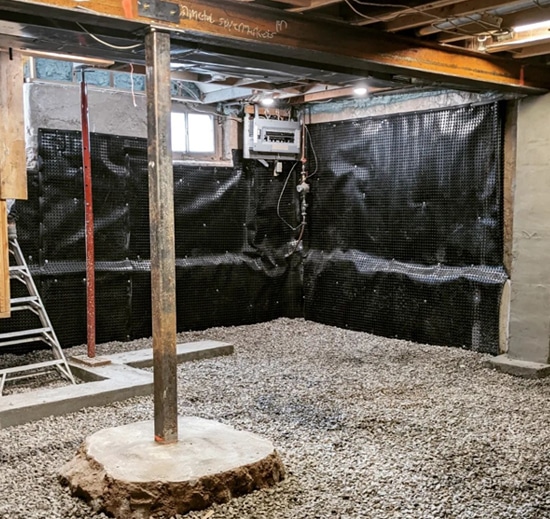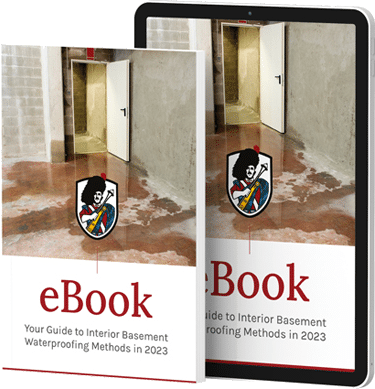Weeping Tile Installation Services in Toronto & GTA
Our Services Are Trusted By








Weeping Tile Installation in Toronto
Water is an ever-present challenge for basements, particularly in a city like Toronto, with its fluctuating weather patterns, old homes, and heavy rainfall. With proper water management, buildings can avoid many problems, including basement flooding, foundation cracks, and mold growth, so efficient water management is crucial when protecting your home or commercial property in Toronto. One often overlooked but essential aspect of this is the installation and maintenance of weeping tiles.
But what are weeping tiles? People often need clarification that the word tile in the name has something to do with flooring. Still, weeping tiles, also referred to as foundation drains or perimeter drains, are pipes with small weep holes that play a crucial role in managing groundwater and surface water around foundations and structures. They aim to prevent moisture buildup and protect the foundation and structure from damage. These drainage systems are designed to capture and divert excess water from the foundation, ensuring it doesn’t seep into the surrounding soil and cause structural issues. They act as a barrier against water infiltration, keeping the foundation dry and stable.

Weeping Tiles Installation Services in Toronto
Benefits of Installing Weeping Tiles

Enjoy a Dry Basement
Weeping tiles efficiently collect and divert groundwater away from the foundation, preventing moisture buildup around the property, thus helping eliminate the risk of basement flooding and water seepage into your basement.

No More Mould and Mildew
Weeping tile installations act as a protective barrier for the foundation by managing water flow and preventing excessive moisture penetration from hydrostatic pressure. Weeping tiles ensure proper water drainage, reducing the conditions necessary for mould formation and protecting indoor air quality.

More Usable Space
By effectively managing water, weeping tiles create a dry and comfortable basement environment. This enables homeowners to utilize their basements for various purposes, such as additional living space, storage, or recreational areas, without concerns about dampness or water-related issues.

Stronger Foundation Structural Integrity
The installation of weeping tiles helps prolong the property's lifespan by preventing water damage through the foundation wall and minimizing the risk of structural issues.

Reduce Costly Repairs and Maintenance
Properly draining weeping tiles can significantly reduce the need for costly repairs and maintenance associated with water-related damage to your foundation. This translates into avoided future costs for property owners over the long run.

Higher Property Value
Restored or repaired weeping tile installations enhance the overall value of the property. Prospective buyers and tenants are attracted to properties with a well-maintained and reliable water management system, as it offers peace of mind and protection against potential water-related issues.
6-Step Process of Installing Weeping Tiles
Interested in Weeping tiles installation or repair? The experts in weeping tile installations in Toronto have listed out the steps to show you how it’s done. Here is an overview of the typical process:
01
Excavation
The first step is to excavate the footings around the area of the foundation. This involves carefully removing soil to expose the foundation walls’ exterior, while the excavation’s depth and width will depend on the specific foundation.
02
Placement of the Drain Pipe
Once the excavation is complete, a perforated drain pipe is placed at the base of the footings and foundation walls. This pipe collects water that accumulates around the foundation and carries it away. The drain pipe is typically corrugated and perforated plastic with a geofabric wrapping to remove debris.
03
Filter Fabric Installation
A filter fabric is placed around the drain pipe to prevent it from becoming clogged with debris. This fabric allows water to pass through, preventing soil particles and other materials from entering the pipe. The filter fabric helps maintain the efficiency of the weeping tiles system over time.
04
Backfilling
After the drain pipe and filter fabric are in place, the weeping tile is covered with 6-8” of clean ¾” gravel. This material provides a stable base and allows for proper drainage. Backfilling is done carefully to ensure the soil grade slopes away from the foundation wall.
05
Regarding
The soil can be regraded once the backfilling is complete to ensure proper water runoff away from the foundation. This step involves angling the soil surface to create a gentle slope that directs water away from the foundation walls.
06
Specialized Techniques and Equipment
Professional installers may employ specialized techniques and equipment to ensure the proper installation and long-lasting performance of weeping tiles. This may include using excavation machinery to expedite the process and provide precision, or they may hand excavate. Professionals also have the expertise to address any specific challenges or requirements unique to the property, ensuring that the installation is tailored to its needs.
Interior Weeping Tile Installation

Suppose you want to create a beautiful and comfortable interior space; an interior weeping tile installation can offer an innovative solution to combat water infiltration and protect your property and foundation from potential water damage. This solution effectively redirects water away from your foundation wall and prevents it from entering your living space.
Interior weeping tile installation begins with thoroughly assessing your interior space and identifying areas prone to water infiltration. Our installation experts then strategically place weeping tiles along the perimeter of your interior walls, effectively capturing and channeling water toward a sump pump system or a designated drainage point. This redirects any potential water damage away from your living areas, preserving the integrity of your foundation walls.
Exterior Weeping Tile Installation
When safeguarding your property in Toronto against water infiltration and potential damage, brand-new exterior weeping tiles installation is necessary. This specialized drainage system is crucial in managing water around the foundation, preventing basement flooding, foundation cracks, and other water-related issues. Exterior weeping tiles provide a proactive solution by collecting water before it reaches the foundation. These drainage systems are a robust defense against potential water-related damage by efficiently diverting water from the property.
The installation process is similar to installing interior weeping tiles, which begins with excavating the area around the foundation to expose the exterior walls. Perforated drain pipes are strategically placed at the base of the foundation (at the footing) and effectively capture and redirect water away from the property. A filter fabric is wrapped around the drain pipes to prevent clogging and enhance water filtration. The excavated area is then carefully backfilled, creating a well-drained foundation perimeter.
Whether you are looking for interior or exterior weeping tiles installation in Toronto, it is crucial to enlist the services of professional contractors experienced in the field, and GJ MacRae Foundation Repair utilizes advanced techniques and equipment to ensure precise installation and long-lasting weeping tile replacement effectiveness.
Why Choose GJ MacRae?
- Highest Rated Customer Service: Customer satisfaction is our primary goal. We will work with you closely to understand your needs and provide the best solution to your foundation repair project.
- Comprehensive Services: With GJ MacRae, homeowners can find all foundation repair solutions under one roof. From foundation crack repair to exterior waterproofing and weeping tile installations, we have the expertise and resources to address your complete waterproofing needs from start to finish.
- Extensive Experience: With nearly 50 years of experience in the industry, GJ MacRae is known for delivering quality, long-term basement waterproofing solutions while tackling even the most challenging waterproofing projects with confidence and expertise.


Protect Your Foundation
- Competitive Pricing: GJ MacRae offers competitive basement waterproofing services without compromising quality. We provide transparent, fair quotes that ensure homeowners receive the best long-term value.
- Quality Materials: GJ MacRae uses high-quality repair materials combined with the latest waterproofing techniques, and we are experts in all phases of basement waterproofing. Plus, we offer innovative solutions that guarantee long-lasting protection against water infiltration.
- Protect Your Investment: When protecting your foundation walls and basement from water damage, choosing GJ MacRae Foundation Repair for basement waterproofing in Toronto ensures you receive the highest quality repair solution to safeguard your foundation long-term.
Basement Waterproofing and Foundation Repair Projects in Toronto and the GTA
Some Kind Words From Our Customers
What Does quality Foundation Repair Look Like?
RECENT PROJECT PHOTOS
RECENT PROJECT VIDEOS
Download Our Free eBook
We’re honored to provide these resources to help you on your journey, and we know reputations are hard to build and easy to lose. That’s why our business is built around two simple promises:
Honesty and Transparency.
We genuinely want each step of your journey (from the very first Google search to a leak-free basement) to be positive!

Weeping Tile Replacement Experts
A new weeping tiles system is one of the best foundation protection methods available! Basements are no longer crawl spaces and can serve a greater purpose. Get creative with your basement and transform that space into your gym, study room, game room, or anything you like. But first, you must have a dry basement.
Need a dry basement? GJ MacRae, the finest weeping tile installation and repair company in Toronto, is here to help. Give us a call or fill out the form below, and our team will inspect your basement situation and provide the ideal basement waterproofing solution. Feel free to contact us at (905) 824-2557 or complete the form below.

Our Service Areas
At GJ MacRae, we take pride in extending our services across the GTA to meet our valued customers’ unique needs, and our dedicated team is committed to delivering top-notch solutions all year long. Our expansive service areas are a testament to our unwavering commitment to the highest quality foundation repair services and customer satisfaction in the GTA.
Schedule a Free Consultation Today
Fill out our request form and we will contact you as soon as possible for a free foundation repair consultation!
Frequently Asked Questions
Installing weeping tile in winter is possible, but an experienced team must undertake it! Some of the difficulties include:
- Due to frozen ground, digging a trench for the weeping tile requires special considerations.
- Excavated soil sitting outside in winter conditions may freeze, so the team undertaking your weeping tile repair in the winter must backfill the repairs by the end of the day to ensure the soil remains thawed.
The life expectancy of a weeping tile system depends on several factors, such as the quality of installation, the type of material, the soil conditions, and the maintenance. If installed and maintained correctly, weeping tile systems can last upwards of a century!
Exterior weeping tile systems are generally installed between 7 and 8ft deep, while interior weeping tiles are installed approximately 12-16″ below the basement floor. However, the depth also depends on the concrete floor’s thickness and the sump pump’s depth.
Expert Waterproofing Services for Your Home
GJ MacRae Foundation Repair has been the industry leader for reliable basement waterproofing in the Greater Toronto Area Since 1975. Nearly five decades of experience inform our proven multi-stage repair process based on below-grade drainage considerations that allow us to waterproof concrete blocks, poured walls, and stone rubble foundation walls properly for the long term. Our repair solutions for leaking foundation cracks include using bitumen-based barrier membranes and high-efficiency weeping tile systems, which give us the edge in reliability and allow for the most robust foundation repair warranty available today in the GTA. Experience the GJ MacRae difference for year-round basement leak repairs in Toronto, Oakville, Mississauga, Burlington, Hamilton, Milton, and Georgetown. If you spot cracked foundation walls, leaky foundations, or any other basement waterproofing issues in your house, reach out and call us today at (905) 824-2557.







